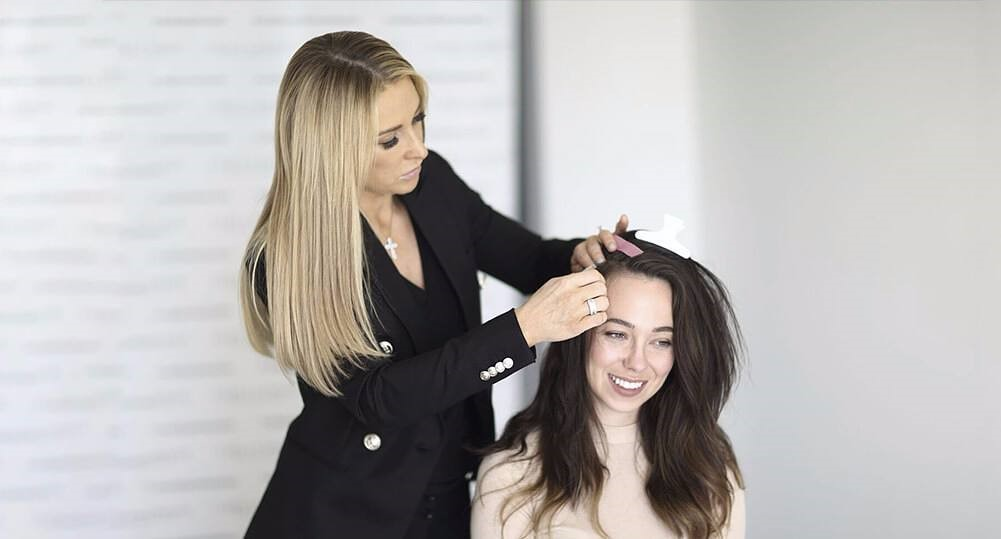
Human hair extensions are made from real, harvested human hair, but can vary greatly in quality and not all hair extensions are made equally.
Low grade hair extensions are generally chemically stripped of the cuticle which removes the whole outer layer. This can cause tangling, matting and hard to manage hair extensions. Stripping the cuticle from the hair creates brittleness, dryness, shorter longevity and reduced UV protection.
Silicone is an artificial product that may give the illusion of shine however it weighs the hair down, creating limp, lifeless hair. Silicones prevent moisture from penetrating the hair shaft and can attract dirt and build up. Some low-grade hair extensions have a silicone coating which may make the hair look lustrous but after several washes, the coating is gone and the hair becomes rough and difficult to comb through, causing breakage.
Remy hair refers to hair that has not been stripped of its cuticle and has been processed to maintain root to tip alignment. As the outer layer is still intact (the cuticle), this hair is of better quality and will last much longer than non-remy hair. The hair extension industry is not regulated so many manufacturers may label non-remy hair as remy and sell for a much higher price.
Another measure of hair quality is the “percentage of full length”. Wefts of hair are often made in differing lengths of hair strands. An average quantity of hair that is 18 inches long may have 20% of the strands measuring the full 18 inches. A further 40% measuring from 14-16 inches and the remaining 40% measuring 6-12 inches.
More superior hair extensions will consist of a higher percentage of full-length hairs. This is widely referred to as double drawn or virtually double drawn. This means the ends of the wefts are almost as think as the top of the weft.
Less expensive hair will have a lower percentage of longer hairs and therefore have thinner ends, traditionally known as tapered ends. This is also referred to as singe drawn.
The most premium hair extensions are made from virgin hair. This type of hair has not been chemically treated or dyed and is in its most natural form, generally cut in ponytail form directly from the donors. Virgin hair is the most expensive of all hair types and blondes or light colours are the most difficult to source, making the value of it even higher.
Below are some tips to help test for hair quality.
Scrunch Test: While holding the hair by the top, place your other hand underneath the ends and push them up until they meet the roots. Rub your hands together to cause slight friction in the hair, then release. Run your fingers through the hair. Your fingers should slide freely through the hair. The more it snags and gets caught, the lower the quality of hair.
Grip Test: Hold the hair at the top, near the weft banding, or secure with a hair tie if it is bulk hair. Slide your hand down the hair and grip it about a quarter of the way down. Repeat this at the mid way point and then three quarters the way down, then grip it just above the tips. Poor quality hair will be noticeably thinner at each step of your grip test. Higher quality hair will be almost he same thickness all the way through.
Wet Tangle Test: A simple way to determine good quality hair extensions is to perform a wet tangle test. This involves holding the extensions at the root and swishing them through shampooed water to replicate the washing process. After doing this several times, we then rinse the hair thoroughly in clean water. If hair cuticles have been inverted with roots and ends now at opposite ends, the hairs will creep up on each other creating a tangled knot near the roots that cannot be removed, even with brushing and conditioner. This tangling occurs because the edges of the cuticles are inverted and catching on each other creating friction, rather than laying flat in a uniform direction like fish scales.
Aftercare products: With processed hair it is important to use the correct aftercare products that will prolong the lifespan and provide enough hydration to the hair as generally most extensions have been chemically altered. Virgin unprocessed har can be a little more forgiving as it has never been processed or chemically altered however it is still important to be using the correct products for the hair type and colour, if required.
Moisture is arguably the single most important factor in determining the way hair extensions look. When the moisture content of the hair drops below 10% (depending on the type of hair and the level of environmental humidity), hair extensions can look brittle and straw like as opposed to healthy.
This critical moisture level is the difference between breakage and elasticity and resistance. The stress and pressure from styling and brushing will be more detrimental to low moisture hair. For this reason, we use a Perma Moisture Treatment to have protein injected into the hair cortex so the hair will not dry out and, subsequently, will greatly increase longevity of the hair with proper maintenance.










